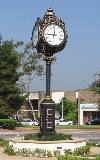Hello from a beautiful sunny day in London!
I’ve just returned from a great weekend trip to Scotland and have been busy drafting essay outlines and my dissertation proposal. Classes are starting to pick up, and I find myself (unfortunately) spending more time in my room doing extra readings and research.
In this blog, I’ll share insights from my Political Economy course then finish with highlights from my trip to Scotland.
The Core-Periphery Model
In my political economy course, we focus on economic trends and analyze the relationship between government and economy.
One important model we’ve learned is the “Core-Periphery Model,” which explains why developing, “periphery” countries have become dependent on developed, “core” countries, and how this structure reinforces itself over time. This entrenchment is due to the direction of trade and difference in elasticities of demand for imports/exports between developing and developed countries.
Key differences before I explain the model:
Trade differences:
Core: Core developed countries tend to import commodities and export manufactured goods.
Periphery: Peripheral developing countries tend to import finished consumer goods and export commodities.
Elasticity of demand differences:
Commodities: Inelastic demand – if income rises by 1%, demand for these goods increases by less than 1% (if at all).
Manufactured goods: Elastic demand – if income rises by 1%, demand for these goods increases by more than 1%
The core-periphery mechanism works as follows:
1. As peripheral countries grow, they demand more imports of finished consumer goods from the core (elastic demand), however their export level of commodities remains about the same (inelastic demand). Imports increase relative to exports.
2. As developing countries’ terms of trade worsen, a long-term problem of trade deficit arises. Ideally these countries would raise foreign exchange for these imports by increasing exports – but the inelasticity of demand for commodities prevents this.
3. Developing countries cannot fund their trade deficits by increasing exports, so they instead turn to borrowing – often borrowing from wealthy core countries. Peripheral debt is financed by the core, and often financed in a foreign currency.
4. Because peripheral countries are dependent on borrowing to allow for increased consumption, they become reliant on funding from the core. These loans often come with contingencies, and peripheral countries become vulnerable to the demands and policy choices of core creditors. This creates a relationship of dependency that is further reinforced as time goes on.
To sum up, trade and elasticity differences create a relationship by which developing countries become dependent on the developed countries.
The only way to break this mold is for the periphery to develop productive capabilities and export higher-value-added goods whose profits can fund increased imports. However, developing countries have trouble competing in more advanced sectors and are often unable to enter these export markets successfully. This leaves them specializing in commodity exports.
Some experts suggest that developed countries rely on this mechanism to maintain access to cheap raw materials and to maintain a large market for our exports. By keeping developing countries dependent on our funding and our exports, developed countries can maintain dominance in the world economic order. Though I’m skeptical that core countries purposefully prevent development for their own advantage, I do recognize the benefits to the core of maintaining this relationship.
One final sidenote:
This explanation of trade direction and elasticities of demand makes me question the validity of the comparative advantage model – is it truly best for countries to specialize in items for which they have a comparative advantage? Is it truly best for countries with an advantage in commodities to specialize just in commodities? By specializing in commodities (inelastic demand), countries limit the possibility of achieving exponential income growth that could fund greater consumption. Manufacturing and services have much more room for innovation/creation of advanced products which could demand a higher premium. If countries only produce inelastically-demanded commodities, how can they increase the value of their exports? How can they afford this premium for imports?
Chinese Business Class Update:
My Chinese class started three weeks ago and we’ve started studying important business terms and dialogues! I’ve learned how to bargain for prices, make deals/sign contracts, and arrange business meetings. We’re also learning how to set up bank accounts and make remittances.
As examples from our dialogues:
想问一下,这几种面料的价格是否可以优惠一点?我们的公司有着很好的发展前景,想和贵公司长期合作。
I’d like to ask if the prices on these fabrics could be lowered a little? Our company has good prospects for development. We’d like to cooperate long-term with your company.
会议的议程是怎么安排的?
What is the agenda of the meeting?
如果我要汇款到美国,该怎么办理?
How can I remit money back to America?
In the coming weeks, I’ll be learning more specialized economic words. I’m working to gain a business fluency by the end of next year!
Personal highlights:
• Last week I spent a long weekend up in Scotland! After enduring my overnight bus ride and arriving in Glasgow at 6:30 in the morning, I immediately grabbed a coffee and watched the sun rise over the city. I first headed to the University of Glasgow (where Adam Smith is a notable alum!) and sat on the eleventh floor of the library catching up on some work. I then walked around the city and explored the Kelvingrove museum before heading back to the city center and joining a hop-on-hop-off bus tour. I sat freezing on the top of the bus as the tour took us around the city. After grabbing another coffee to warm up, I then hopped on an hour-long bus ride to Edinburgh!
• The next day, my friend Karen and I travelled to St. Andrew’s. We had brunch at Northpoint cafe (where William and Kate apparently often got coffee together!), explored the old castle and church, and walked alongside the coast and golf course. My friend Merrilee, who studies at St. Andrews (and whom I met on our summer language program in Russia!), gave us a great history tour of the city, explaining the Scottish Reformation and showing us important landmarks in the city including the spot where Patrick Hamilton gave speeches.

• My final two days were spent in Edinburgh. Karen has been studying abroad at Edinburgh for two months and was the best tour guide – taking me around old and new Edinburgh, showing me the cafe where J.K Rowling drafted the first Harry Potter, taking me on a hike up Arthur’s Seat for a stunning view of the city, and taking me up Calton Hill for the best view of the Guy Fawkes’ fireworks show. Had to take a picture with the Adam Smith statue to send to my economics professor back at Dartmouth!
• Karen reciprocated the visit and joined me for two great days in London! We walked East and West London and watched Wicked at the Apollo theatre. After she left, I spent the weekend in London. On Saturday I grabbed brunch with a friend in South London and went for a run around Clapham Commons. On Sunday, I went for 10-mile run/walk (mainly walk) around London – stopping at the Camden Market, running to Hampstead Heath and to Primrose Hill for views of the city, and grabbing a croissant at the Marylebone market before running back home to finish up some work.
Picture
As project and essay deadlines are coming up, I’m spending more hours in my dorm getting work done. However I’m still making time to enjoy all London has to offer – tomorrow I head to the ATP finals to watch Nadal play tennis!
Cheers!




